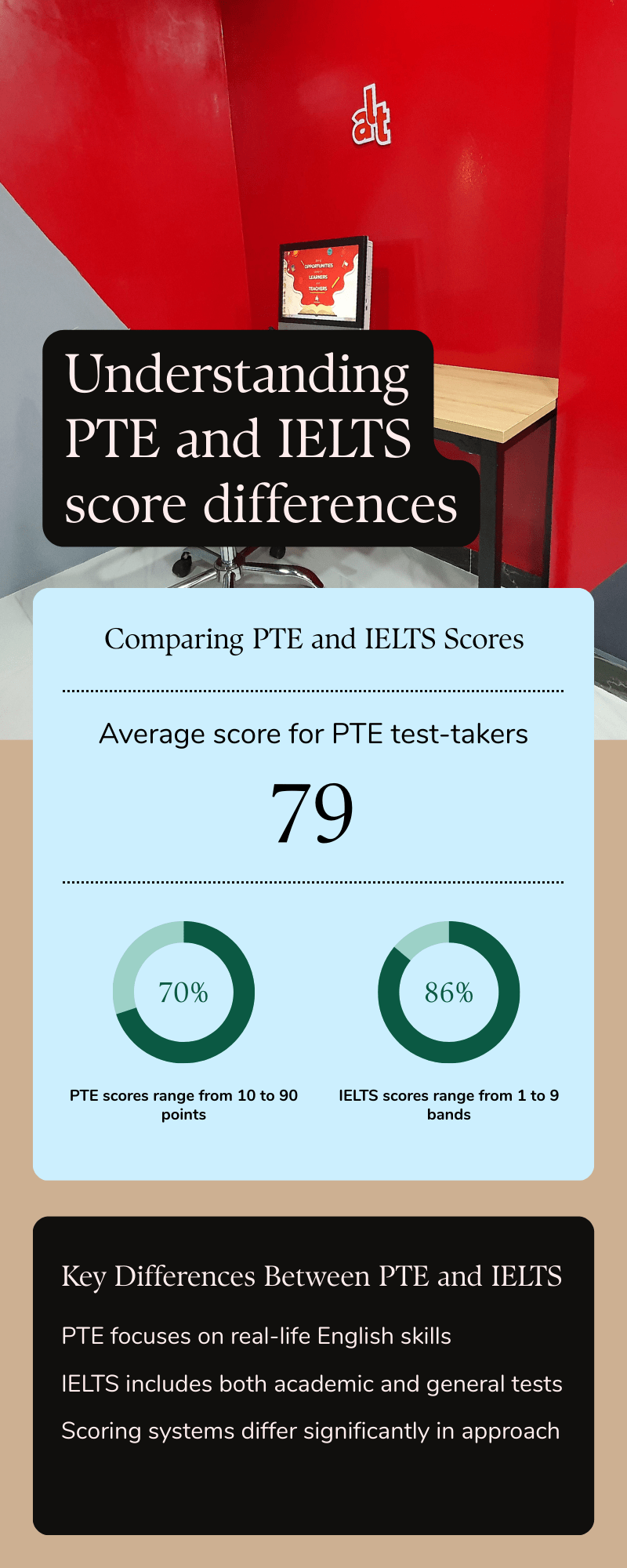The Pearson Test of English (PTE) Academic and the International English Language Testing System (IELTS) are two of the most widely recognized English proficiency exams for non-native speakers.
Both tests assess the ability to communicate effectively in English for academic, professional, and immigration purposes, and they are accepted by thousands of universities, colleges, and government bodies in countries like Australia, Canada, the UK, the USA, and New Zealand.
Despite their shared goal, PTE and IELTS differ significantly in format, administration, scoring, and evaluation methods. To assist candidates, many institutions provide score conversion charts to equate PTE and IELTS scores, enabling flexibility for applicants.
As of August 2025, updates to the PTE Academic, including new tasks and refined scoring, have further distinguished it from IELTS, while conversion charts remain a valuable tool.
This article explores the key differences between PTE and IELTS, their scoring systems, score comparisons, and preparation strategies using freeptetest resources, incorporating the latest updates for 2025.
Overview of PTE and IELTS
PTE Academic
PTE Academic is a fully computer-based test designed to evaluate speaking, writing, reading, and listening skills in an academic context. Conducted at secure Pearson VUE test centers, it uses artificial intelligence (AI) for scoring, supplemented by human oversight for select tasks since the 2025 updates.
The test, lasting approximately 2 to 2.15 hours, includes 65–75 tasks across three sections: Speaking and Writing, Reading, and Listening. Its rapid result delivery (within 2 business days) and objective scoring make it a popular choice for students and visa applicants.
The 2025 updates introduced two new speaking tasks—Summarize Group Discussion and Respond to a Situation—enhancing its focus on real-world communication.
IELTS
IELTS offers two modules: Academic (for higher education) and General Training (for immigration and professional purposes). It is available in paper-based and computer-based formats, with the Speaking section conducted face-to-face with a human examiner.
The test, lasting about 2 hours and 45 minutes, assesses the same four skills but is structured differently, with separate sections for each. IELTS is known for its standardized 9-band scoring system, with results available within 3–13 days depending on the format.
Its human-based scoring for speaking and writing adds a subjective element, contrasting with PTE’s AI-driven approach.
Both tests are widely accepted, but their differences in administration and scoring can influence a candidate’s choice. Freeptetest resources can help candidates understand these differences and prepare effectively for either test.
Key Differences Between PTE and IELTS
Test Format and Administration
- PTE Academic: Fully computer-based, PTE is conducted in a single session at a test center using a computer and headset. It features 22 task types, such as Read Aloud, Write Essay, and Summarize Spoken Text, with integrated tasks (e.g., Re-tell Lecture assessing both listening and speaking). The 2025 updates increased the task count to 65–75, with the Speaking and Writing section extended to 76–84 minutes. The test uses academic content like lectures and graphs, with diverse accents.
- IELTS: Available in paper-based or computer-based formats, IELTS comprises four sections: Listening (30 minutes), Reading (60 minutes), Writing (60 minutes), and Speaking (11–14 minutes). The Speaking section is a face-to-face interview with an examiner, conducted separately. Tasks include essay writing, multiple-choice questions, and short-answer responses, using both academic (Academic module) and everyday content (General Training module). The test duration is approximately 2 hours and 45 minutes, with an optional 10-minute break for PTE but not for IELTS.
Scoring Methods
- PTE Academic: Scored on a granular scale of 10–90, PTE provides an overall score, communicative skills scores (speaking, writing, reading, listening), and enabling skills scores (grammar, oral fluency, pronunciation, spelling, vocabulary, written discourse). The 2025 updates introduced human review for five tasks, including Write Essay, to assess content originality, while AI handles fluency and pronunciation. Results are available within 2 business days.
- IELTS: Scored on a 9-band scale (1–9), IELTS reports an overall band score (the average of the four skills) and individual band scores for each section. Scores are in whole or half bands (e.g., 6.0, 6.5). Speaking and Writing are evaluated by human examiners, while Listening and Reading are marked objectively. Results take 3–5 days for computer-based tests and up to 13 days for paper-based tests.
Content and Focus
- PTE Academic: Focuses on academic English, with tasks simulating university-level scenarios (e.g., summarizing lectures or describing charts). Integrated tasks assess multiple skills simultaneously, and the test includes diverse accents to reflect real-world communication. The 2025 updates emphasize spontaneous speaking, discouraging memorized responses.
- IELTS: The Academic module targets academic English, while the General Training module focuses on everyday contexts for immigration or work. Tasks are standalone, with Writing and Speaking emphasizing real-life scenarios (e.g., writing a letter for General Training). The face-to-face Speaking test assesses conversational fluency with an examiner.
Test Environment
- PTE Academic: Conducted in a controlled, quiet test center with individual computer stations, ensuring consistency. The AI-driven scoring eliminates human bias, accommodating various accents.
- IELTS: The Speaking section involves interaction with a human examiner, which can be more subjective but allows for natural conversation. The test environment varies slightly between paper-based and computer-based formats, with paper-based tests requiring handwritten responses.

Score Comparison and Conversion
To facilitate acceptance, many institutions and governments provide conversion charts to equate PTE and IELTS scores. These charts are based on extensive research to align the tests’ proficiency levels, despite their differing scoring scales. Below is an updated comparison table for 2025, reflecting PTE’s refined scoring system:
IELTS Band Score | PTE Academic Score | Proficiency Level | Comments |
9.0 | 86–90 | Expert | Near-native fluency |
8.5 | 83–86 | Very Good | Advanced proficiency |
8.0 | 79–83 | Very Good | Strong command of English |
7.5 | 73–79 | Good | Proficient for academic purposes |
7.0 | 65–73 | Good | Suitable for most university admissions |
6.5 | 58–65 | Competent | Adequate for many visas and programs |
6.0 | 50–58 | Competent | Basic academic or immigration requirements |
5.5 | 43–50 | Modest | Limited proficiency, suitable for some purposes |
5.0 | 36–43 | Modest | Basic communication skills |
4.5 | 30–36 | Limited | Minimal proficiency |
Examples of Score Requirements
- IELTS 7.0 (no sub-band less than 7.0): Equivalent to a PTE Academic overall score of 66, with minimums of 66 in listening, 67 in reading, 65 in speaking, and 82 in writing. This is common for university admissions or skilled worker visas.
- IELTS 6.5 (no sub-band less than 6.0): Equivalent to a PTE Academic overall score of 58, with minimums of 48 in listening, 53 in reading, 46 in speaking, and 62 in writing. This meets requirements for many student visas or professional certifications.
These conversions are widely accepted by universities and immigration authorities, allowing candidates to submit PTE scores when IELTS is required, or vice versa. Freeptetest provides updated conversion tools to help candidates align their scores with institutional requirements.
Choosing Between PTE and IELTS
The choice between PTE and IELTS depends on individual preferences, strengths, and goals:
- Technology Comfort: PTE is ideal for candidates comfortable with computers, as it is fully digital. IELTS offers a paper-based option for those less familiar with technology.
- Speaking Preference: PTE’s speaking tasks involve talking to a microphone, suitable for those preferring AI evaluation. IELTS’s face-to-face interview may appeal to candidates confident in conversational settings.
- Time Sensitivity: PTE’s 2-day result turnaround is faster than IELTS’s 3–13 days, making it better for urgent applications.
- Task Integration: PTE’s integrated tasks (e.g., Re-tell Lecture) assess multiple skills simultaneously, while IELTS evaluates each skill separately, which may suit candidates who prefer distinct sections.
- Immigration vs. Academic Goals: IELTS General Training is preferred for immigration, while PTE Academic and IELTS Academic are suited for university admissions. PTE Academic UKVI is specific for UK visa applications.
Freeptetest offers diagnostic tools to help candidates assess which test aligns with their strengths and goals.
Preparation Strategies with freeptetest
Effective preparation is key to achieving target scores in either test. Freeptetest provides tailored resources for both PTE and IELTS, updated for 2025.
Preparing for PTE Academic
- Understand the Format: Study the 22 task types, including new tasks like Summarize Group Discussion, using freeptetest guides.
- Practice Mock Tests: Freeptetest’s timed simulations replicate the test environment, helping you master tasks like Describe Image or Write Essay.
- Focus on New Tasks: Practice Summarize Group Discussion by summarizing multi-speaker podcasts and Respond to a Situation by role-playing real-life scenarios (e.g., giving directions).
- Enhance Academic Skills: Use freeptetest prompts to improve essay structure and academic vocabulary. Practice listening to diverse accents for tasks like Write from Dictation.
- Avoid Memorized Responses: The 2025 updates penalize templated answers, so practice spontaneous speaking with freeptetest exercises.
Preparing for IELTS
- Familiarize with Sections: Use freeptetest to practice IELTS’s four sections, focusing on Writing Task 2 (essay) and Speaking Part 2 (monologue).
- Simulate Speaking Tests: Practice face-to-face conversations with a tutor or freeptetest prompts to mimic the IELTS Speaking interview.
- Improve Writing: Use freeptetest to practice Task 1 (describing visuals for Academic or letter-writing for General Training) and Task 2 essays, focusing on coherence and grammar.
- Practice Under Timed Conditions: Freeptetest’s mock tests help build speed for Reading and Listening sections, which have strict time limits.
Allocate 4–8 weeks for preparation, using freeptetest to track progress and target weaknesses. Both tests require daily practice in all four skills, with emphasis on time management and authentic responses.
Impact of 2025 Updates on PTE Academic
The August 2025 updates to PTE Academic have refined its structure and scoring:
- New Tasks: Summarize Group Discussion and Respond to a Situation enhance real-world applicability, testing critical listening and spontaneous speaking.
- Increased Task Count: 65–75 tasks, with more speaking tasks for comprehensive assessment.
- Refined Scoring: Expanded human review for five tasks and AI detection of memorized responses ensure fairness.
- Faster Results: Delivery within 2 business days, compared to IELTS’s longer turnaround.
- Extended Speaking and Writing Section: Now 76–84 minutes, accommodating new tasks.
These updates, integrated into freeptetest materials, make PTE Academic more rigorous but maintain its efficiency and objectivity.
Cost and Accessibility
As of 2025, exam fees vary by region but are approximately:
- PTE Academic: Around INR 13,400 (subject to change).
- IELTS: Around INR 12,650 for paper-based or computer-based tests.
PTE is available year-round at over 400 test centers globally, with flexible booking. IELTS offers frequent test dates but may have limited availability for paper-based tests. Freeptetest provides booking guides to help candidates secure slots.
PTE Academic and IELTS are both robust English proficiency tests, but their differences in format, scoring, and administration cater to varied candidate needs.
PTE’s computer-based, AI-driven approach offers rapid results and objective scoring, while IELTS’s human-evaluated Speaking section and optional paper-based format appeal to those preferring traditional testing.
The 2025 PTE updates enhance its real-world relevance, and score conversion charts ensure flexibility for institutions. By leveraging freeptetest resources, candidates can prepare effectively, align scores with requirements (e.g., PTE 66 for IELTS 7.0), and choose the test best suited to their goals, whether for academic admissions, visas, or professional certifications.



